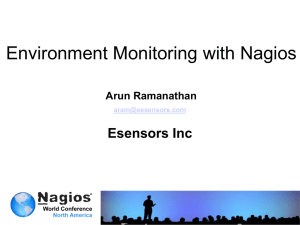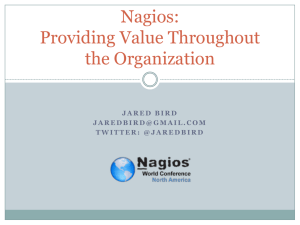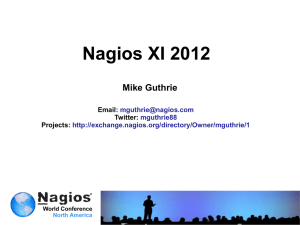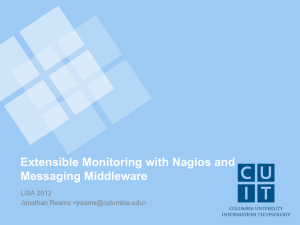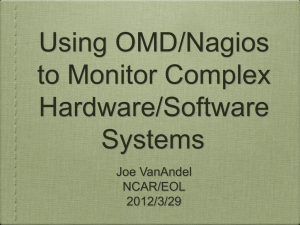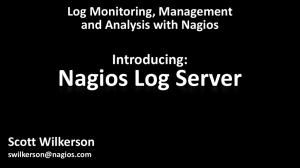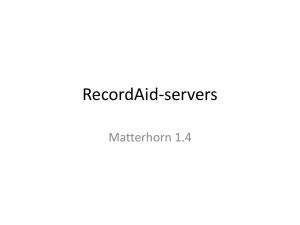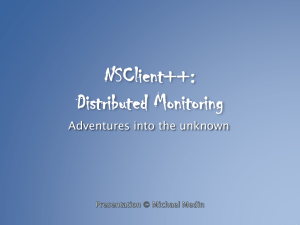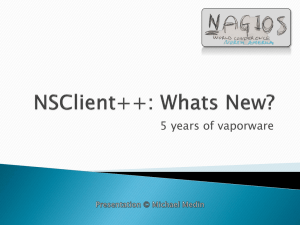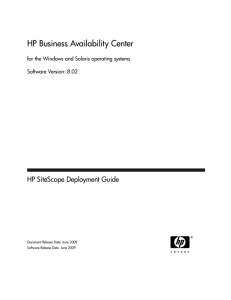Jeff Sly - Case Study Nagios @ Nu Skin
advertisement
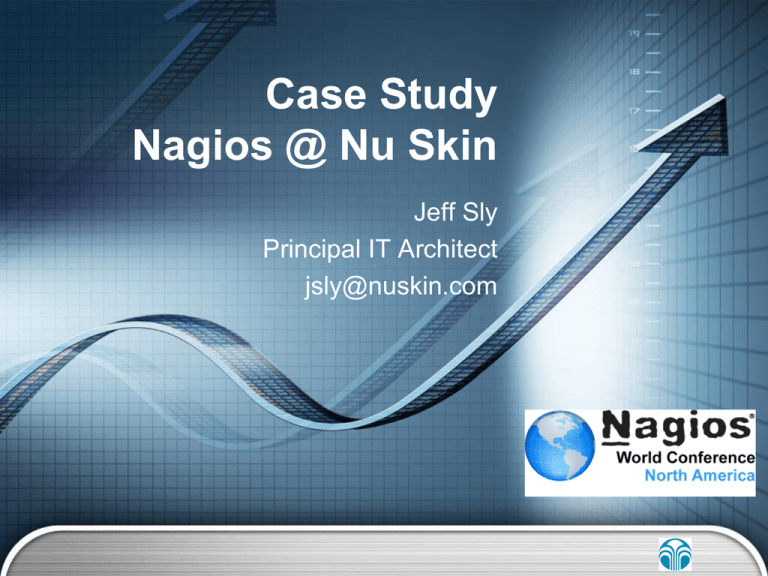
Case Study Nagios @ Nu Skin Jeff Sly Principal IT Architect jsly@nuskin.com Who is in the Audience? How many of you are: Suppliers of Nagios or some value add-on for Nagios? Customers using Nagios? Just implementing Nagios or expanding implementation? Using NagiosXI? Who is Nu Skin? Our Technology Footprint Ecommerce – Home grown Applications – Java, EJB, ABAP, .Net Databases – Oracle, MySQL, MSSQL OS – HPUX, Redhat, Windows, VMWare ERP – SAP Supply Chain, CRM, FI Datacenters – 6 locations in 6 countries Offices – 50 Countries Monitoring Goals Monitoring presents operations with a completely integrated global view. Good monitoring is proactive; it helps teams prevent problems from becoming outages. Good monitoring helps minimize outage downtime, quickly identify root cause and contacts correct people. Centralized Monitoring System Our Monitoring History We tried for 10 years… Do it all in ‘One Tool Projects’ One Monitoring Tool to rule them all: Mercury SiteScope Remedy Help Desk HP OpenView Quest Foglight Home grown (several) One monitoring person • He decided to quit! Could never get everything All Failed – We always gave up! Why? Servers and agents that were proprietary Huge foot print inefficient performance Steep learning curve Very expensive Updates costly and very time consuming System Administrators like their own scripts, can see what they are doing Resulting Monitoring Issues Tried to make Operations clearing house for all warnings and alerts from 10+ tools Operations was overwhelmed Took 4 process steps and lots of software to notify of critical failures Most Administrators setup own private monitoring to receive warnings Many false notifications Late notifications As Is (start of project) Our Business Customers were Unhappy Old Monitoring Work Flow Four steps to notify system administrator Step 1: Everything Emails Operations Email HelpDesk Error Network HP NNM System Scripts Nagios Database SiteScope 8 Foglight Sitescope 6 BAC Step 2: Operations Opens Email Email HelpDesk Error Network HP NNM System Scripts Nagios Database SiteScope 8 Foglight Sitescope 6 BAC Step 3: Operations Checks Source Email HelpDesk Error Network HP NNM System Scripts Nagios Database SiteScope 8 Foglight Sitescope 6 BAC Step 4: Operations Calls admin Email HelpDesk Error Network HP NNM System Scripts Nagios Database SiteSco pe 8 Foglight Sitescope 6 BAC Inventory of Existing Checks Regular Expression found on Web Page Monitoring HTTP Check - Up or Down Ping Host Up or Down PORT monitoring FTP checking SMTP checking SNMP monitoring - no trap catching yet Radius DNS monitoring Disk Space monitoring CPU and Load Average monitoring Memory Monitoring Inventory of Existing Checks Service monitoring Transaction monitoring page load times – performance graph Website click through (Webinject not working) Log File monitor –parse for Errors Java HEAP, Thread, Threadlock monitoring Apache thread and worker count monitors Ecommerce shop monitors Email can send and receive SQL query ODBC (catalog ODBC had bugs) To Be Happy Customers Key Ideas 1. 2. 3. 4. 5. MoM Tool Requirements Shared Ownership Lowest Level Nagios Monitor Method Idea 1: MoM Our first “break though” was the idea that even through we needed a centralized view for all monitoring that did not mean all monitoring had to be done by one monitoring tool. We had to pick a “Manager of the Monitors” (MoM) to bring together the best of breed monitoring. MoM - according to Gartner Idea 2: Tool Requirements Open – not proprietary and closed Mainstream – wanted good native support and strong community Interface – to 3rd Party Monitoring Flexible – adapt to many types of monitoring Efficient – minimal foot print on production servers, not chatty on network Notification – granular control Reliable – good clean architecture Usability – GUI interface, reporting Idea 3: Shared Ownership Core team Operation of Monitoring Environment: backups, upgrades, & custom plug-ins Monitoring Experts Training Monitoring leads in Development & Admin teams: Set up own monitors Keep own monitors current Adjust monitors If something is not monitored not core teams fault Operations Owned Monitoring Email HelpDesk Error Network HP NNM System Scripts Nagios Database SiteScope 8 Foglight Sitescope 6 BAC Team Leads Own Monitoring Operations Network Asia System Scripts Europe Database Web SAP How to Guides How to Setup NRPE - HPUX Idea 4: Lowest Level Handle alerts at the lowest possible level in the organization Only forward alerts if not handled at lower levels before they become critical Handle events at lowest level Operations Network Asia System Scripts Europe Database Web SAP Only forward unhandled alerts Network Asia System Scripts Europe Database Web SAP Idea 5: Nagios Monitor Method Choose the Nagios Monitoring Method Active Check from Nagios Server (normal) Active Check performed by remote client NRPE, NSClient Passive Check – Listen to 3rd party monitors NSCA Active Local Check Web Nagios HTTP or Ping Unix DB DB Monitor Win Active Remote Check - UX Web Nagios CPU, RAM (NRPE) Unix DB DB Monitor Win Active Remote Check - Win Web Nagios CPU, RAM (NSClient) Unix DB DB Monitor Win Passive 3rd Party Alert Web Nagios 3rd Party Alert NSCA Unix DB DB Monitor 3rd Party Check DB Win Bonus Idea - Tune Tune the database Add Ram Drive Tune the Database Modify contents of the /etc/my.cnf [mysqld] section. tmp_table_size=524288000 max_heap_table_size=524288000 table_cache=768 set-variable=max_connections=100 wait_timeout=7800 query_cache_size = 12582912 query_cache_limit=80000 thread_cache_size = 4 join_buffer_size = 128K http://web3us.com Info on: MySQL Tuning, Nagios Tuning RAM Drive Create a RAM disk for Nagios tempory files I created a ramdisk by adding the following entry to the /etc/fstab file: none /mnt/ram tmpfs size=500M 00 Mount the disk using the following commands # mkdir -p /mnt/ram; mount /mnt/ram Verify the disk was mounted and created # df -k Modify the /usr/local/nagios/etc/nagios.cfg file with the following tuned parameters temp_file=/mnt/ram/nagios.tmp temp_path=/mnt/ram status_file=/mnt/ram/status.dat precached_object_file=/mnt/ram/objects.precache object_cache_file=/mnt/ram/objects.cache Implementation Methodology Site Survey Inventory existing monitors Proof of concept Build new environment Migrate monitors from each platform to Nagios, one at a time Integrate OEM, and to send monitors to Nagios Three Project Phases Deliver something useful in each phase Build a level at a time Phase I 1. 2. 3. 4. 5. 6. 7. 8. 9. Set up a pilot of Nagios XI using Trial License. Set up Foglight monitoring of JVM (Java Virtual Machine). Purchase NagiosXI and Consulting Support Bring in a consultant for two weeks to help set up the architecture and help us work with the system. Documentation Web Site for Nagios learning's and “How to guides” Define a set of standards and guidelines to follow to help aid an effective monitoring process. Backups on Running on Production Nagios Server Set up services which aren't being caught right now and move a few of the important services over to the new Nagios XI monitoring system. Test Nagios plugins and server performance Phase II 1. 2. 3. 4. 5. Migrate off of Sitescope 6 and shutdown Migrate off of Sitescope 8 and shutdown Decommission Foglight Clean up the old monitoring server Migrate the network team from old Nagios to core NagiosXI system 6. Set up standby NagiosXI system, cron to replicate weekly 7. Research missing alerts and add them to the new NagiosXI system Phase III 1. Implement Global Monitoring Add monitors for existing international systems Add monitors using JMX to monitor Java servers Nagios Remote Process Execution (NRPE) to monitor remotely Remote Monitoring for Windows Servers (NS Client++) Implement notification and escalation of alerts Add monitors for critical business functions Phase III continued… 2. Corporate Enhancements Request recurring down time enhancement from Ethan Galstad Automate refresh of NagiosXI standby system Build Network Map Retire Windows SiteScope Add monitors for phone systems Add monitors to data center (UPS, Temperature, Humidity) Integrate to SAP Tidal monitoring tool Phase III continued… 3. Business Business review and approve SLA (using business terms) Monitor both the Business Functions and the individual point devices that provide the Business Function Follow the Sun with Eyes on Glass. Training How to setup alerts How to receive alerts How to report on performance graphs Create a new Dashboard for HelpDesk and International IT Staff Inventory of Monitor Checks Qty 50 170 600 100 10 8 5 4 16 Things we figured out how to do from Nagios Regular Expression found on Web Page Monitoring HTTP Check - Up or down Ping Host Up or down PORT monitoring FTP checking SMTP checking SNMP monitoring - no trap catching yet Radius DNS monitoring 250 Disk Space monitoring 170 CPU and Load Average monitoring 170 Memory Monitoring Solution HTTP Check HTTP Check Nagios Check alive Check TCP port # Nagios FTP plugin Nagios SMTP plugin Not Using Nagios plugin, difficult Nagios Check DNS NSClient, NRPE -Nagios Disk plugin NSClient, NRPE - Custom Linux plugin NSClient, NRPE -Custom Linux plugin Inventory continued… Qty Things we figured out how to do from Nagios 170 Memory Monitoring 80 Service monitoring Transaction monitoring - page load times performance data graphs 30 Website click through (webinject not working) 10 Log File monitor -p parse for Errors 30 6 Day HEAP, Thread, Threadlock monitoring 8 Apache thread and worker count monitors 18 ShopApp and SignupApp monitors 5 Email can send and receive Solution NSClient, NRPE -Custom Linux plugin NSClient, NRPE with bash shell script Custom using Selenium Scripts Custom using mechanize NRPE - script parse log files Java Management Extensions (JMX) Custom plugin Apache statics HTTP Check Custom app status page Custom Nagios plugin Nagios XI Interface Data Centers in 7 Countries IT Operations Goal Quick Notification & Recovery from Outage Type of Notification of outages with details Monitor on which system is down, so we know who to contact Solution Migrate from Sitescope, Openview to NagiosXI IT Team Managers Goal Prevention of outage Type of Warnings about conditions before Monitor outages occur, allow for corrective actions that will prevent likely outages Solution Migrate from Sitescope, Openview to NagiosXI, Integrate OEM SAP and Scripts with Nagios Summary 1. MoM ~ Manager of Managers Allow specialized tools 2. 3. 4. 5. Tool Requirements, enough but not all Ownership for implementation, shared Handle alerts, lowest level in organization Choose Nagios monitoring method Tips, Tricks & Demos Nagios XI Large Implementation Day 3, 2:00 Track 3 (Nate Broderick) 3 Demos Performance challenges and solutions Integrating monitoring solutions Oracle Migrating from BAC & Foglight Customization Graphing, and more.

